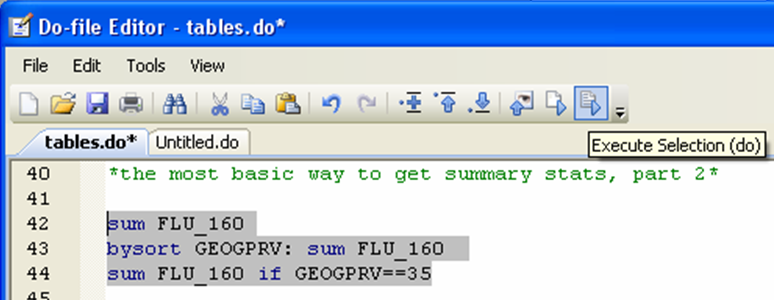
While this is cumbersome, it can certainly be done. The source of the difference is described in the Stata manual.īriefly put, Stata is estimating \sigma^ Of 2.744, the calculation above reports 118.126. While Weisberg reports an estimated error variance Note particularly that the residual mean square is Where the differences occur is in the analysis of variance table.Īlthough the F statistic is the same in ALR as in Stata, the sums of When we compare this output to Table 4.2 in ALR, we see that theĪll agree with the values reported above. Note that these frequency weights must, by definition, be positive The regression command would look something like: Performed by using frequency weights in this (condensed) data set. Who had that set of values in a new Stata variable. Time, and then also recording the number of individuals in the sample Smaller by simply listing each unique set of (Y,X) values a single In this case, the data set can be made much Useful when many individuals in the sample have identical values for YĪnd all of the X's. [Another type of weights, called frequency weights, are (only) appropriate kinds of weights to use for this problem. What Stata refers to as analytic weights. Our first approach is to use the regress command in Stata, Which we calculate from the column of SD's provided in Table 4.1. Thus, we must first generate a Stata variable containing the weights, In the physics data, Weisberg takes the variance (sigma 2) to be Proportional to the inverses of the individual item You should have your copy of Weisberg open asĪs Weisberg formulates the problem, the weights w i are
#Stata summation how to
Use this data set to show how to obtain the WLS results tabulated on Physics data described in Weisberg's example 4.1 (p. Least-squares estimates for problems such as the ``Strong interaction'' Stata command that you can use ( wls) to calculate weighted This document is intended to clarify the issues, and to describe a new
#Stata summation manual
Stata Reference Manual regress pp 130-132.] [See, for instance, Weisberg pp 82-87, and That you understand both what Stata is doing and what it is that Reconciling Stata's and Weisberg's versions of WLSĪs noted in class, Stata and Weisberg differ slightly in the way that
#Stata summation code
Below is a simplified version of the code that will yield the exact same results as above.Weighted Least Squares Weighted Least Squares Computations using Stata Ronald A Thisted 1 November 1998 Further in the latest versions of Stata we can combine sort and by into a single statement. We can make use of the “*” wildcard to indicates that we wish to use all the variables. If you have a lot of variables in the dataset, it could take a long time to type them all out twice. Finally, we list the observations for which _N is greater than 1, thereby identifying the duplicate observations. Then we use all of the variable in the by statement and set set n equal to the total number of observations that are identical. In this example we sort the observations by all of the variables. Now let’s use _N to find duplicate observations.īy id score x1 x2 y1 y2 z1 z2: generate n = _N Let’s use _n to find out if there are duplicate id numbers in the following data:Īs it turns out, observations 6 and 7 have the same id numbers and but different score values. To list the highest score for each group use the following: To list the lowest score for each group use the following: Now n1 is the observation number within each group and n2 is the total number of observations for each group. Of course, to use the by command we must first sort our data on the by variable. Using _n and _N in conjunction with the by command can produce some very useful results. Let’s see how _n and _N work.Īs you can see, the variable id contains observation number running from 1 to 7 and nt is the total number of observations, which is 7.

_N is Stata notation for the total number of observations.

_n is 1 in the first observation, 2 in the second, 3 in the third, and so on. _n is Stata notation for the current observation number. Stata has two built-in variables called _n and _N.


 0 kommentar(er)
0 kommentar(er)
